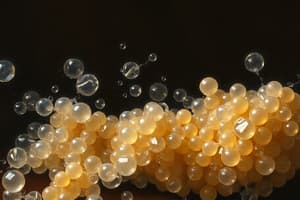Podcast
Questions and Answers
What is the molar mass of a compound composed of two nitrogen atoms and four oxygen atoms ($N_2O_4$)? (Molar mass of N = 14.01 g/mol, O = 16.00 g/mol)
What is the molar mass of a compound composed of two nitrogen atoms and four oxygen atoms ($N_2O_4$)? (Molar mass of N = 14.01 g/mol, O = 16.00 g/mol)
- 30.01 g/mol
- 46.01 g/mol
- 92.02 g/mol (correct)
- 76.01 g/mol
How many grams of NaCl (molar mass = 58.44 g/mol) are needed to have 2.5 moles?
How many grams of NaCl (molar mass = 58.44 g/mol) are needed to have 2.5 moles?
- 116.88 grams
- 146.10 grams (correct)
- 23.38 grams
- 29.22 grams
How many moles are present in 11.2 liters of $O_2$ gas at STP?
How many moles are present in 11.2 liters of $O_2$ gas at STP?
- 0.5 moles (correct)
- 1.0 moles
- 2.0 moles
- 1.5 moles
If a reaction requires 0.25 moles of $H_2SO_4$ (molar mass = 98.08 g/mol), what mass of $H_2SO_4$ is needed?
If a reaction requires 0.25 moles of $H_2SO_4$ (molar mass = 98.08 g/mol), what mass of $H_2SO_4$ is needed?
How many molecules are there in 0.75 moles of $H_2O$?
How many molecules are there in 0.75 moles of $H_2O$?
You have a sample containing $1.2044 \times 10^{24}$ atoms of carbon. How many moles of carbon do you have?
You have a sample containing $1.2044 \times 10^{24}$ atoms of carbon. How many moles of carbon do you have?
What volume will 3.0 moles of nitrogen gas ($N_2$) occupy at standard temperature and pressure (STP)?
What volume will 3.0 moles of nitrogen gas ($N_2$) occupy at standard temperature and pressure (STP)?
If you have 44.0 grams of carbon dioxide ($CO_2$), how many moles do you have? (Molar mass of $CO_2$ is 44.0 g/mol)
If you have 44.0 grams of carbon dioxide ($CO_2$), how many moles do you have? (Molar mass of $CO_2$ is 44.0 g/mol)
A container holds 88 grams of $CO_2$ gas. How many molecules of $CO_2$ are present in the container (Molar mass of $CO_2$ = 44 g/mol)?
A container holds 88 grams of $CO_2$ gas. How many molecules of $CO_2$ are present in the container (Molar mass of $CO_2$ = 44 g/mol)?
What volume is occupied by 0.5 moles of hydrogen gas ($H_2$) at STP?
What volume is occupied by 0.5 moles of hydrogen gas ($H_2$) at STP?
Flashcards
What is a mole?
What is a mole?
The amount of a substance containing exactly 6.02214076 × 10^23 entities.
What is Avogadro's Number?
What is Avogadro's Number?
6.02214076 × 10^23, the number of entities (atoms, molecules, etc.) in one mole.
What is molar mass?
What is molar mass?
The mass of one mole of a substance, expressed in grams per mole (g/mol).
How to find a compound's molar mass?
How to find a compound's molar mass?
Signup and view all the flashcards
Moles to grams equation
Moles to grams equation
Signup and view all the flashcards
Grams to moles equation
Grams to moles equation
Signup and view all the flashcards
Moles to particles equation
Moles to particles equation
Signup and view all the flashcards
Particles to moles equation
Particles to moles equation
Signup and view all the flashcards
What is the molar volume of gas at STP?
What is the molar volume of gas at STP?
Signup and view all the flashcards
What is stoichiometry?
What is stoichiometry?
Signup and view all the flashcards
Study Notes
- The mole serves as a crucial unit in chemistry for expressing the quantity of a chemical substance.
- A mole is defined as precisely 6.02214076 × 10^23 entities, which can be atoms, molecules, ions, or other specified particles.
- Avogadro's number, commonly represented as NA, is the term for this value.
- The mole concept creates a connection between the atomic and macroscopic scales, enabling chemists to handle measurable amounts of substances while accounting for the number of atoms or molecules involved.
Determining Molar Mass
- Molar mass refers to the mass of one mole of a substance.
- For elements, the molar mass has the same numerical value as the element's atomic mass, expressed in atomic mass units (amu).
- The periodic table provides this value.
- The units for molar mass are grams per mole (g/mol).
- For compounds, the molar mass involves summing the molar masses of each atom in the chemical formula.
- As an example, water (H2O) has a molar mass of roughly (2 × 1.008 g/mol for H) + (1 × 16.00 g/mol for O) = 18.016 g/mol.
Mole Conversions
- Mole conversions commonly involve conversions between moles and grams, moles and the number of particles, and moles and volume, specifically for gases.
- Molar mass and Avogadro's number act as conversion factors in these processes.
Converting Moles to Grams
- Multiply the number of moles by the substance's molar mass to convert moles to grams:
- grams = moles × molar mass
Converting Grams to Moles
- Divide the mass in grams by the substance's molar mass to convert grams to moles:
- moles = grams / molar mass
Converting Moles to Number of Particles
- To convert moles to the number of particles, multiply the number of moles by Avogadro's number:
- number of particles = moles × Avogadro's number
Converting Number of Particles to Moles
- Divide the number of particles by Avogadro's number to convert the number of particles to moles:
- moles = number of particles / Avogadro's number
Molar Volume of Gases
- One mole of an ideal gas occupies about 22.4 liters at standard temperature and pressure (STP, which is 0 °C and 1 atm).
- At STP, this volume is known as the molar volume of a gas.
- Multiply the number of moles by 22.4 L/mol to convert moles of a gas at STP to volume:
- volume = moles × 22.4 L/mol (at STP)
- Divide the volume by 22.4 L/mol to convert the volume of a gas at STP to moles:
- moles = volume / 22.4 L/mol (at STP)
Applications of Moles and Molar Conversions
- Moles and molar conversions are crucial for stoichiometry, which studies the quantitative connections between reactants and products in chemical reactions.
- They facilitate calculations to determine the amounts of reactants needed to yield a particular amount of product, or the amount of product resulting from a given amount of reactant.
- Molar conversions play a vital role in preparing solutions of specific concentrations.
- Molarity (M), is used to express the concentration of a solution, and is defined as the number of moles of solute per liter of solution.
Studying That Suits You
Use AI to generate personalized quizzes and flashcards to suit your learning preferences.
Description
Understand the mole concept, a crucial unit in chemistry for expressing the amount of a chemical substance. Learn how one mole is defined by Avogadro's number. Explore how to determine molar mass for both elements and compounds using the periodic table.




